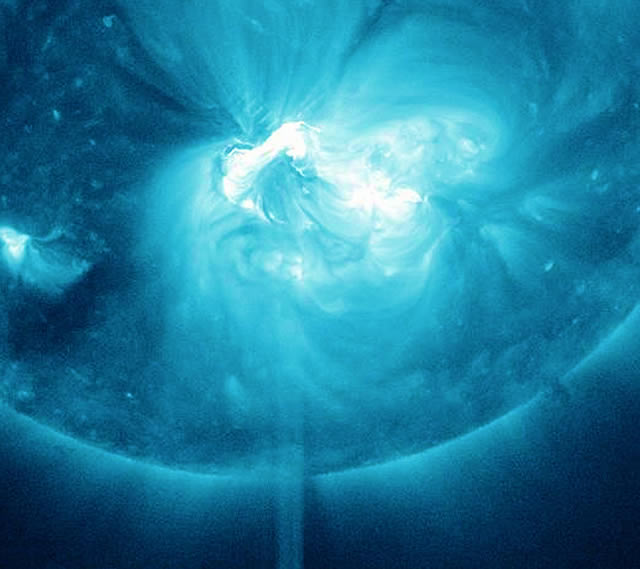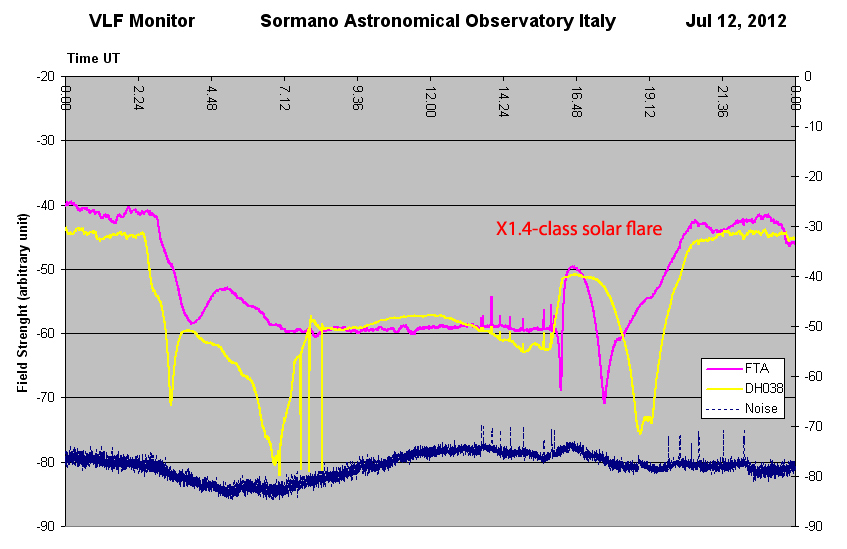
Photo: Solar Flares From Giant Sunspot AR1520
An X1.4 class flare erupted from the center of the sun, peaking on July 12, 2012 at 12:52 PM EDT. It erupted from Active Region 1520 which rotated into view on July 6. [Credit: NASA/SDO/AIA]
Source/Continue reading → Space.com
Update: Early estimates by NASA’s GSFC Space Weather Center are for a moderate to severe geomagnetic storm (G2-G4 on NOAA scale; Kp index 6 to 8).
Big sunspot AR1520 unleashed an X1.4-class solar flare on July 12th at 1653 UT. Because this sunspot is directly facing Earth, everything about the blast was geoeffective. For one thing, it hurled a coronal mass ejection (CME) directly toward our planet. According to a forecast track prepared by analysts at the Goddard Space Weather Lab, the CME will hit Earth on July 14th around 10:20 UT (+/- 7 hours) and could spark strong geomagnetic storms. Sky watchers should be alert for auroras this weekend. The explosion also strobed Earth with a pulse of extreme UV radiation.
The UV pulse partially ionized Earth’s upper atmosphere, disturbing the normal propagation of radio signals around the planet. Monitoring stations in Norway, Ireland and Italy recorded the sudden ionospheric disturbance. Finally, solar protons accelerated by the blast are swarming around Earth. The radiation storm, in progress, ranks “S1” on NOAA space weather scales, which means it poses no serious threat to satellites or astronauts. This could change if the storm continues to intensify. Stay tuned.
Source/Continue reading → SpaceWeather.com
@denebofficial A video explanation of #solarflare classes as well: youtube.com/watch?v=oOXVZo… #spaceweather
— Francis Reddy (@francisreddy) Luglio 12, 2012
La gigantesca macchia solare denominata AR1520, apparsa sul sole il 6 luglio scorso, ha rilasciato una potente esplosione, dal centro del disco solare, di Classe X1.4, oggi 12 luglio 2012. Sul sito del NOAA tutti gli aggiornamenti in diretta: www.swpc.noaa.gov sul rilascio di massa coronale (CME) e sull’impatto che potrebbe dare luogo ad una tempesta geomagnetica dall’entità prevista, al momento, come minore. (G1).
Aggiornamento: Ulteriori analisi prevedono la possibilità che si verifichi una tempesta geomagnetica tra G2 (moderata) e G4 (Severa).
L’impulso UV ha parzialmente ionizzato la parte superiore dell’atmosfera, disturbando la normale propagazione dei segnali radio intorno al Pianeta. Centraline di controllo in Norvegia, Irlanda e in Italia hanno rilevato il disturbo. Infine, Particelle protoniche, rilasciate dall’esplosione, pullulano intorno alla Terra. La tempesta di radiazioni, in corso, si attesta ad “S1”, sulla scala del NOAA, quindi di entità minore e non comporterebbe un serio pericolo per gli astronauti in orbita sulla Stazione Spaziale Internazionale (ISS) e per i nostri satelliti.
Aggiornamenti rapidi su Twitter, visibili qui in alto, a destra.
NOAA ALERT: Geomagnetic K-index of 6 – Active Warning: Yes – NOAA Scale: G2 – Moderate. #solarstorm #solarflare #CME #SpaceWeather #sun
— DENEB Official © (@denebofficial) Luglio 15, 2012
La tempesta solare geomagnetica annunciata dopo l’X Flare dei giorni scorsi è arrivata e si attesta ora su scala del NOAA come G2/moderata.
— DENEB Official © (@denebofficial) Luglio 15, 2012
Solar storm: Federal agencies provide conflicting, confusing information wapo.st/PVBKN9 #SpaceWeather #solarflare #solarstorm #CME
— DENEB Official © (@denebofficial) Luglio 14, 2012
Le previsioni sull’intensità della tempesta geomagnetica in arrivo sono incerte. Su scala del NOAA, max G5, fonti diverse danno da G1 a G4.
— DENEB Official © (@denebofficial) Luglio 14, 2012

Magnetic fields above big sunspot AR 1520 erupted sparking a X1.4 solar flare. X-rays bathed the dayside of our planet and sent a wave of ionization rippling through the atmosphere over Europe. The sudden ionospheric disturbance (SID) disrupted propagation of VLF radio signals a phenomenon recorded at the Sormano Astronomical Observatory, Italy.
Source/Continue reading → SpaceWeather.com
Il grafico riporta il disturbo improvviso della ionosfera (SID) che ha interferito sulla propagazione di segnali radio VLF, fenomeno registrato dall’Osservatorio Astronomico di Sormano, Italia.





















